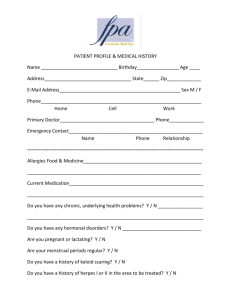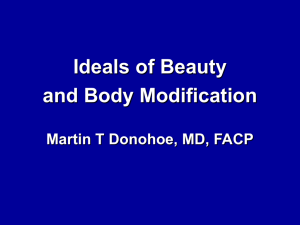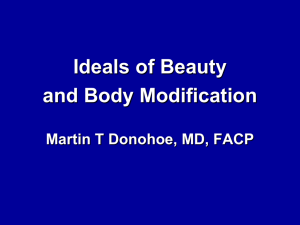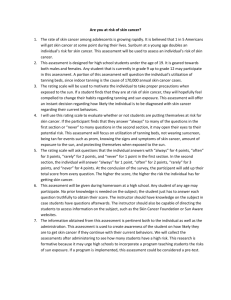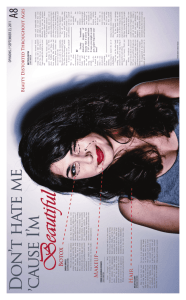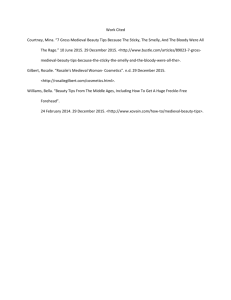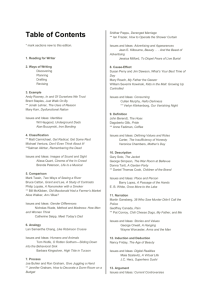Ideals of Beauty and Methods of Body Modification
advertisement
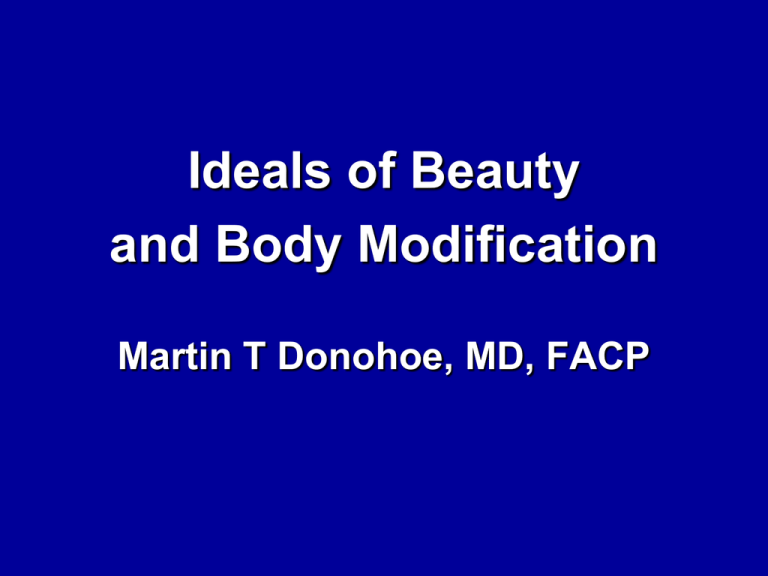
Ideals of Beauty and Body Modification Martin T Donohoe, MD, FACP Historical Ideals of Beauty • Ancient Greeks valued symmetry • Contemporary definitions similar: – “Ideal woman”: small chin, delicate jaws, full lips, small nose, high cheek bones, large and widely spaced eyes, and waist:hip ratio of 0.7 – “Ideal man”: taller, waist:hip ratio of 0.9, dominant/rectangular face/chin, deep-set eyes, heavy brow • Suggests strong supply of testosterone “Ugly” • Common first name in Ancient Greece, parts of sub-Saharan Africa • Idea: give children bad names so demons won’t find them • Other favorites: “Disagreeable,” “Crippled” Historical Ideals of Beauty • Scarification – dates back at least 4,000 years • Chinese foot binding – pain, osteoporosis, falls/imbalance – Surgery to reshape women’s feet for stiletto heels increasingly popular • Ancient Greek newborn female baby wrapping Historical Ideals of Beauty • Ancient Roman women colored their lips with red cinnabar stone, a type of mercury ore, lined their faces with white lead, and rouged their cheeks with red lead • Ancient Egyptians/Roman/Persians: antimony for conjunctival sparkle • Rome to medieval Europe: paleness preferred Historical Ideals of Beauty • Renaissance women used leeches on their ears to drain blood from their faces for a fashionably pale complexion • Elizabethan hair plucking, ceruse makeup • Elizabethans used lard to set wigs, which could result in rat infestations Historical Ideals of Beauty • Court of Louis XVI: blue veins drawn on neck and shoulders to emphasize noble blood • 16th & 17th century: belladona eye drops Historical Ideals of Beauty • 18th Century: vermillion makeup (sulfur and mercury) • 14th - 19th century: corsetting (whalebone and steel) – precursor to the girdle/Spanx – Making a comeback at both high- and lowend retailers (takes up to 30 minutes to lace up; requires an extra set of hands) Historical Ideals of Beauty • Unibrow: – Sign of criminal tendencies in Victorian England; mark of beauty in contemporary Iran • 19th Century: Vacuum pumps and vibration therapy for baldness/”flabby skin”; mercury-based freckle remover Historical Ideals of Beauty • Efik people of the Nigerian coast, others: fattening rituals • Breast implants (since 1903 Charles Miller, MD) –First silicone breast enlargement 1962 Contemporary Ideals of Beauty • “Better Baby Contests” – Eugenic Movement / Social Darwinism – Today – “Baby Bangs” • Tapeworms (Maria Callas) • Rib removal (Cher?) • Prostitutes using diuretics (for weight loss), child sex workers forced to take dexamethasone (to look older, “curvier”) Contemporary Ideals of Beauty • Botox injections • Plastic surgery • Abusive subjugation of women through body modification – female genital mutilation – Cultural components Ideals of Beauty • Brass neck rings (Paduang people of Burma) • Lip and earlobe expanders (certain African tribes) • Tattoos, body piercings, wings Ideals of Beauty • Wonderbra, Brava Bra ($2500, suction device worn overnight for 10 weeks, promises 1 cup increase (actual increase ½ cup size), can cause broken blood vessels, skin rash, discomfort) • Wonderbum pantyhose (DuPont Lycra) – promises a “perfectly peachy, pert bottom” • Music industry depictions of beauty Ideals of Beauty • Ancient Greeks – symmetry – Remains true – Familiarity, personality traits also important • Evolutionary adaptation for survival of human species – Size, muscle power, pathogen-free status, fertility The Perks of Beauty • The good-looking are more likely to have higher self-esteem, date more, get higher grades, graduate from college, get married, be hired, get paid more (including tips), and be promoted sooner • Lifetime earnings difference between the typical “good-looking” and “below average-looking” worker = $230,000 The Perks of Beauty • Height is associated with income and leadership positions – Ironically, 50 years ago some women were treated with estrogen to prevent them from growing too tall and becoming unmarriable – This impaired their fertility, among other consequences • Strangers are more likely to assist good-looking people in distress The Perks of Beauty • The pretty/handsome are less likely to be reported, caught, accused, or punished for a minor or major crime • Role of ageism (more important for women) • The responsibility: – Attractiveness is recognized as a special gift, and its misuse is not tolerated The Adonis Complex • 38% of men want bigger pectorals; 34% of women want bigger breasts • Each year, men spend over $2 billion on health club memberships and $2 billion for home exercise equipment • Tommy John surgery – To enhance elbow strength and improve pitching velocity Anabolic Steroid Abuse • Supplement industry booming • 3 million American men have swallowed or injected anabolic steroids since they became widely available in the 1960s Anabolic Steroid Abuse • 2.5-6.0% of current middle and high school students have used anabolic steroids (100% increase over last 6 years); rates higher among boys – Use associated with violent behavior • 35% use protein powders/shakes to build muscle Adonis Complex of the Middle Aged and Elderly • “Low T (testosterone) Syndrome” • Hypogonadism is a real disorder, but “Low T Syndrome” manufactured by drug companies to treat those with stunted libidos and depressed mood – “Treatment” carries increased risk of cardiovascular disease, BPH, prostate cancer Cosmetics • Concocted at home prior to 20th Century • Industry spawned by: – “Allure” of prostitutes/sexuality – Mass popularity of anti-aging products in 1920s – Women entering workforce – Migrations to cities • Food, Drug and Cosmetic Act (1938) Cosmetics • Worldwide annual spending around $19 billion ($8 billion in US) – 33% more than the amount needed each year (in addition to current expenditures) to provide water and sanitation for all people in developing nations – Slightly more than the amount needed each year (in addition to current expenditures) to provide reproductive healthcare for all women in developing countries Cosmetics • Average American adult uses 9 personal care products/day (with 126 unique chemical ingredients) –89% of the over 10,500 ingredients used in personal care products never tested for toxicity –Little FDA oversight Cosmetics • Most contain carcinogens and/or endocrine disruptors (see http://www.cosmeticsdatabase.com/) • Unusual/dangerous ingredients include: – Mercury – skin creams – Lead – lipstick and kohl (decorative black eyeliner, alleged to help children’s eyes develop and protect them against curses) – Arsenic, Cadmium, Copper, aluminum – Bacteria – mascara Cosmetics • Unusual/dangerous ingredients include: – Mica (lung-damaging particles) – Cow colostrum – Gold – Foreskin – Placenta/Fetal cells – Paint stripper and varnish - eyeliner Cosmetics and Hair Coloring • Women devote average of 19 minutes per day to treating and altering their faces • 55% of American women between 13 and 70 color their hair –1/8 American men between 16 and 60 Hair Care Products • African-American “hair relaxers” contain endocrine disruptors – Use increases risk of uterine fibroids, cancers • Brazilian Blowout hair straightening products contain formaldehyde (possible carcinogen) Scented Products • Many cosmetics, perfumes, colognes, air freshener sprays, candles, oils, and gels contain fragrances – Some fragrances toxic – Many contain allergens • 30% of Americans report skin irritation or headaches with at least some scented products Cosmetics • 2013: EU bans sale of all cosmetics tested on animals Tanning • The skin’s response to ultraviolet light injury • No such thing as a “safe tan” • 95% of Americans understand that sunburns are dangerous, but 81% still think they look better with a tan. Tanning • UVA and UVB dangerous • Ozone damage allows greater UV radiation exposure – Estimated lifetime risk of melanoma 1/70 • Clouds filter out only 20% of sun’s UV rays • Snow reflects up to 80% of UV rays (sand 17%) • White T-shirt has SPF 7 (min 15 recommended); darker shirts have higher SPFs Tanning • High sun exposure during childhood increases risk of melanoma • High sun exposures during adulthood increases risk for nonmelanoma skin cancers (squamous and basal cell) Artificial Tanning • 36% of adults, 25% of teens, and 55% of college students use a tanning lamp each year (females more than males) • More than 90% of users are aware that premature aging and skin cancer are possible complications of tanning lamp use (melanoma and basal cell) Artificial Tanning • WHO: tanning beds cause cancer –450,000 cases of basal and squamous cell skin cancer and 11,000 cases of melanoma each year attributable to indoor tanning in the U.S., Australia, and Europe –Melanoma rate up 200% 1973-2014 Skin Cancers – Other Estimates • Skin cancers of all types rising: 1/5 Americans will get during their lifetimes • Increased lifetime melanoma risk –1/1500 - 1930 –1/68 – today –Due mostly to ozone destruction, which is reversing due to Montreal Protocol (phaseout of CFCs) Tanning Facilities • Over 50,000 in US (more than the number of Starbucks or McDonalds) • Found at 50% of colleges • Generate revenues of over $5 billion/yr Tanning Facilities • Most countries do not limit access of youths to tanning parlors (Australia and Brazil have banned them altogether) • Most US states limit access of youths (bans; parental consent) • FDA regulates as moderate risk devices, requires black box warning for minors (but does not outlaw or restrict use by minors) • Indoor 10% tanning tax implemented in 2010 as part of PPACA (Obama Health Care Plan) Tanning • Tanning as a substance abuse-like disorder – Associated with other addictions • Excessive indoor tanning associated with depression, suicide attempts • Tanning produces endorphins – some contain fragrances – can cause allergic reactions – Sprays may damage lungs Tanning • Mineral sunscreens best (Zn or Titanium); lotions and creams do not necessarily protect against UVA) • Use SPF of at least 15 and re-apply frequently – Avoid benzophenone (aka oxybenzone, estrogenic); avobenzone is safer Artificial Tanning • Many lotions, creams, and sprays available – Most contain dihydroxyacetone (DHA) – can damage DNA and lungs and cause allergic reactions • International Smart Tan Network– PR campaign opposing the “sun scare industry” • “Natural” does not necessarily mean safe • See EWG database Artificial Tanning • Increased (but not excessive) carotenoidcontaining fruit and vegetable consumption can improve skin color • Tanning pills (not approved for use) containing canthaxanthin dangerous • Skin lightening creams may contain mercury, hydrocortisone, vitamin A, and hydroquinine (used to develop photographs) Tattooing • Roman Empire used to brand convicts, slaves, and army deserters • Tattoo from Tahitian word “tatau” (“to mark”) • Reached apogee among Maori • Popularized in West by sailors returning from Polynesia Tattooing • Aesthetic choice • Initiation rite • Time-saving way for disabled to overcome difficulties of applying makeup • Adjuvant to reconstructive surgery (particularly face and breast, to simulate natural pigmentation) Tattooing • 80 million Americans have permanent tattoos • Ancient practice: Egyptian mummies, Maori tribesmen, Thracian women of 5th Century Greece, Moors) • Tattooing still illegal in South Carolina and Oklahoma Tattooing • More than 50 different pigments and inks employed – Many contain heavy metals, phthalates, other endocrine disruptors and carcinogens – Some contain industrial grade printer’s ink or automobile paint – Red dyes most allergenic Tattooing • FDA considers inks to be cosmetics (premarketing safety evaluation required) • FDA considers pigments to be “color additives” (no premarketing safety evaluation required) Risks of Tattooing • Tattooing associated with risky behaviors in adolescents • Infection – e.g., Staph, Strep, Mycobacteria, hepatitis B, C, syphilis, leprosy, and HIV (HIV risk theoretical – no cases identified to date) – Am Assn Blood Banks requires one-year wait between getting tattoo and donating blood • Allergic reactions Risks of Tattooing • • • • • Granulomas Keloid formation MRI complications Swellings/burns Image quality suffers (particularly with permanent mascara) • Removal problems The Most Common Problem: Dissatisfaction • 10% of those getting tattoo experience adverse reactions (infections, allergies, etc.) • > 1/3 of those tattooed later regret it – Chief reason = the person’s name in the tattoo • Practitioners’ skill levels vary widely • Fading with time • Blurring when injections too deep The Most Common Problem: Dissatisfaction • Human body changes with time • Styles come and go • With facial cosmetic surgery, appearance of tattoos and permanent makeup may become distorted Tattoo Removal Techniques • Laser treatments (photothermolysis) – Requires multiple treatments • • • • • Dermabrasion Salabrasion Scarification Surgical Removal Camouflaging Temporary Tattoos • Fade after several days • Allergic reactions • FDA alert re risks with foreign-made products • Freedom-2 Ink, Infinitink: Biodegradable dye capsules – when zapped by laser, dyes absorbed by body and tattoo disappears Risks of Henna Tattoos • Henna products risky – Henna approved for use as a hair dye, not for injection into the skin – Produces a reddish-brown tint, raising questions about what ingredients are added to produce the varieties of colors labeled as henna (e.g., “black henna,” “blue henna” – Color can last for more than a week Body Piercing • 36% of Americans • Women > Men • Complications: 20-40% – Skin irritation and infections most common Body Piercing Complications • Other complications include auricular chondritis, nasal cartilage destruction, abscesses, contact dermatitis, bleeding, bladder infections, dental trauma, and other secondary trauma • Death rare • Avoid shopping mall kiosks • Unclear if prophylactic antibiotics helpful The Fringes • Snail slime facials to make skin soft (South America) • Nightingale dung facials to bleach and brighten skin (Japan, “The Geisha Facial”) • “Vampire Facelift”: patient’s own blood injected into face to smooth out wrinkles • Face slapping by massueses The Fringes • Merkins (pubic hair wigs – used throughout history – allow male actors to play females; hide STDs; decorative; etc.) • Pubic hair implants (abundant pubic hair associated with fertility in South Korea) The Fringes • Anal bleaching – Initially porn stars and sex workers – Now available to general public for $75/treatment – Can cause eczema • Red labial dye (“My New Pink Button”) The Fringes • Money: Jim Nelson auctioned off his head on eBay for a corporate logo tattoo in 2003 • Others sell tattoo space on their bodies Botox • Botulinum toxin: – Cause of botulism – potential biowarfare/bioterror agent • Medical Uses: blepharospasm, spasmodic torticollis, migraines, back spasms, chronic pain, axillary hyperhidrosis, BPH, autonomic disorders, wrinkles due to normal aging • Unlikely to work on sun- or smoking-induced wrinkles Botox • Manufacturer = Allergan (Acquired by Actavis in 2014) – Allergan also markets Latisse (bimatoprost, the same ingredient in the glaucoma treatment Lumigan) for topical “treatment” of “hypertrichosis of the eyelashes” (eyelash transplant alternative) – Myobloc, Dysport, and Xeomin (other botulinum neurotoxins) – -Limited standardization Botox • 4.8 million procedures in 2009 • Large direct-to-consumer ad campaign – Olympians Mark Spitz, Nadia Comanici involved • $80/dose + physician’s fee ($443 avg.) Botox • Most users white, age 35-50 • 12% are men • In-home Botox parties; Botox scams; counterfeit Botox (ineffective and/or dangerous) • Hollywood actors Botox • Retreatments required q 3-4 months • Side effects: muscle weakness, masklike facies, drooling, slurred speech, aspiration, dysphagia, dysnpnea, rare allergic reactions; may spread via neurons back to spinal cord or even CNS – 87 hospitalizations, 16 deaths reported 1997-2006 – FDA boxed warning 2009 Rivals to Botox • Collagen injections (from cows, possible allergic responses) • Perlane (“natural” collagen alternative from human tissue) • Fat injections • Cold thermal injury • Face lift/eyelid surgery Dermal Fillers • Alternative to botox • Cow collagen, liquid silicone, plastic microbeads, synthetic bone and ground-up human cadaver skin (association with for-profit tissue banks) • Deoxycholic acid (Kybella) – destroys fat cell membranes (can also destroy skin cells, if injected into them) Dermal Fillers • $700-$900 per treatment (lasts a few months) – Compare with $4000-$6000 for a facelift, which lasts 10-15 yrs before requiring touch-ups • Risks – Include renal failure, retinal artery occlusion Conclusions • Ideals of beauty: some relatively constant, others change • Multiple methods of body modification: some dangerous, even abusive Covered in Other Slide Shows • Cosmetic surgery • Female genital cutting • Body weight and the obesity epidemic • Ethical and policy issues References • Donohoe MT. Beauty and body modification. Medscape Ob/Gyn and Women’s Health 2006;11(1): posted 4/19/06. Available at http://www.medscape.com/viewarticle/529442 • Donohoe MT. Cosmetic surgery past, present, and future: scope, ethics and policy. Medscape Ob/Gyn and Women’s Health 2006;11(2): posted 8/28/06. Available at http://www.medscape.com/viewarticle/542448 Re Tanning • See slide show by Anuru and Salmon on risks and regulations related to indoor tanning at http://phsj.org/?page_id=10 Contact Information Public Health and Social Justice Website http://www.phsj.org martindonohoe@phsj.org
